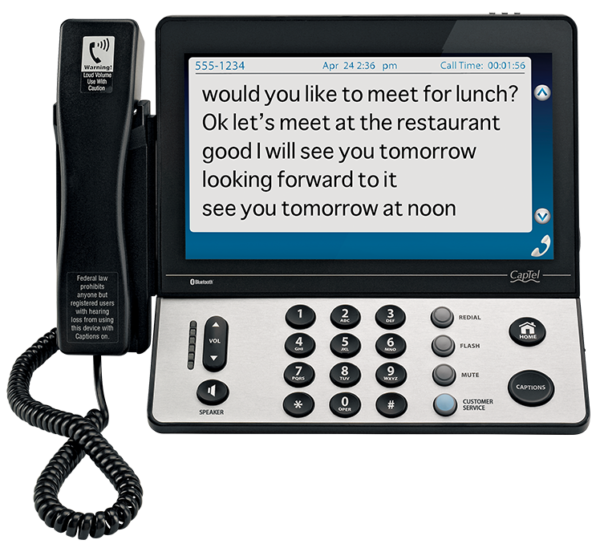Captioned Telephone Service
Captioned Telephone service, currently available in the United States, enables people with hearing loss to see captions of everything their caller says over the phone.

In the same way that closed captions help people with hearing loss to enjoy watching TV, captioned telephone service lets individuals with hearing loss see captions of their telephone calls. A captioned telephone looks and acts like any other traditional telephone with one important difference: it shows word-for-word captions of everything the caller says.
Currently available in the United States and through programs in Australia and New Zealand, captioned telephone service is considered a major development in telecommunications access for people with hearing loss. Since its approval for use in the U.S. in 2003, captioned telephone service has steadily grown to now be the largest relay service offered for people with hearing loss.
How Does Captioned Telephone Service Work?
Individuals make and answer calls the same way they normally would. Each call is connected through a captioning service, where specially trained operators use speech-recognition technology to transcribe everything the other person says into captions that appear on the captioned telephone display. The user can hear the other person with whatever hearing ability they have, and at the same time they can read the captions to confirm what was said. There are two components to every call – the captioning service which transcribes the caller’s words, and the captioned telephone itself where the captions appear during each call.
The process is entirely automatic and transparent to the user. From the user’s perspective, they simply pick up the phone and dial a call like they always would. They can make or receive calls without needing to dial special service number. Then, they are able to read the captions to be certain of what their caller says.
Why is Captioned Telephone Service Important?
“There is an entire segment of the population that has difficulty hearing, but would not necessarily consider themselves deaf or a candidate for hearing aids,” explains Barbara Dreyfus, vice president of CapTel, Inc. “Telephone conversations in particular can be challenging to understand, even if people hear clearly in face-to-face settings. Traditional solutions for people who are deaf, such as TTY equipment, is not a good fit for this group.”
“Not being able to hear over the phone can be very isolating,” continues Ms. Dreyfus. “Studies show the importance of staying socially connected, especially as we age, yet people with hearing loss tend to shy away from using the phone. Captioned telephones restore people’s independence and confidence over the phone, knowing they will catch every word.”
Hearing health professionals note that captioned telephone service works nicely in support of other hearing loss solutions. For example, Cochlear implant recipients report the captions are helpful to re-inforce and confirm they are hearing the spoken words correctly over the phone. Hearing aid wearers note the convenience of reading captions for detailed information, such as receiving driving directions or medical advice, which often can be challenging to understand over the phone.
Why is Captioned Telephone Service Not Available Everywhere?
In order to offer captioned telephone service on a widespread basis, a funding program must be in place to cover the cost of providing the captioning service. In the U.S., the captioning service is available nationwide as part of the Telecommunications Relay Service (TRS) program, which was established under the Americans with Disabilities Act (ADA) to make telephone services accessible for people with hearing loss. The funding for TRS comes from a federally-regulated fund administered by the Federal Communications Commission (FCC) that collects a small amount from each telephone company’s long-distance revenues to pay for the cost of the service. The net result: individual consumers in the U.S. do not need to pay to use the captioning service. Comparable funding arrangements, administered through each country’s government, are in effect in Australia and New Zealand, enabling captioning service to be provided in these areas. Without a similar funding program in place, captioned telephone service is not possible on a widespread basis.
Help bring captioned telephone services to Canada by signing a petition administered by the Canadian Hard of Hearing Association.

